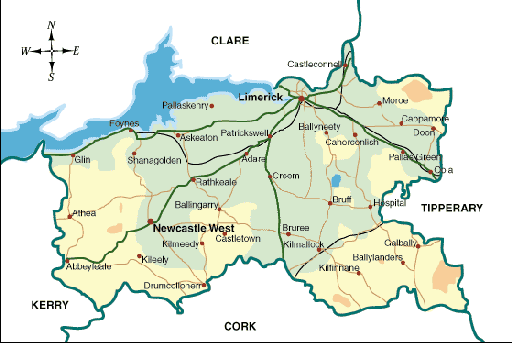Overview
County Limerick (Contae Luimnigh) is a county in the province of Munster, located in the mid-west of Ireland with County Clare to the north, County Cork to the south, County Kerry to the west and County Tipperary to the east. The River Shannon flows through the city of Limerick and into the Atlantic Ocean at the north of the county. Below the city, the waterway is known as the Shannon Estuary. Because the estuary is shallow, the county's most important port is several kilometres west of Limerick city, at Foynes.
Newcastle West is the most important county town outside of Limerick city. Other towns mainly lie along the Limerick - Tralee roads (N69, N20) and Limerick - Cork road (N21).
History
It is thought that man had established himself in the Lough Gur area of the county as early as 3000 BC, while megalithic remains found at Duntryleague date back further to 3500 BC. The arrival of the Celts around 400 BC brought about the division of the county into petty kingdoms or tuath.
Christianity came to Limerick in the 5th Century, and resulted in the establishment of important monasteries in Limerick, at Ardpatrick, Mungret and Kileedy. From this golden age in Ireland of learning and art (5th - 9th Centuries) comes one of Ireland's greatest artefacts, The Ardagh Chalice, a masterpiece of metalwork, which was found in a west Limerick fort in 1868.
The arrival of the Vikings in the 9th century brought about the establishment of the city on an island on the River Shannon in 922. The death of Donal Mór O'Brien, King of Munster in 1194 resulted in the invading Normans taking control of Limerick, and in 1210, the County of Limerick was formally established. Over time, the Normans became "more Irish than the Irish themselves" as the saying goes. The Tudors in England wanted to curb the power of these Gaelicised Norman Rulers and centralise all power in their hands, so they established colonies of English in the county. This caused the leading Limerick Normans, The Geraldines, to revolt against English Rule in 1569. This sparked a savage war in Munster known as the Desmond Rebellions, during which the province was laid to waste, and the confiscation of the vast estates of the Geraldines.
The county was to be further ravaged by war over the next century. Limerick was not fought over for most of the Irish Confederate Wars, of 1641-53, being safely behind the front lines of the Catholic Confederate Ireland. However it became a battleground during the Cromwellian conquest of Ireland in 1649-53. The invasion of the forces of Oliver Cromwell in the 1650s included a twelve month siege of the city by Cromwell's New Model Army led by Henry Ireton. The city finally surrendered in October 1651. During the Jacobite-Williamite War (1689-1691) the city was to endure two further sieges, one in 1690 and another in 1691. It was during the 1690 siege that the infamous destruction of the Williamite guns at Ballyneety, near Pallasgreen was carried out by the heroic defender of Limerick, General Patrick Sarsfield The Catholic Irish, comprising the vast majority of the population, had eagerly supported the Jacobite cause, however, the second siege of Limerick resulted in a defeat to the Williamites. Sarsfield managed to force the Williamites to sign the Treaty of Limerick, the terms of which were satisfactory to the Irish. However the Treaty was subsequently dishonoured by the English and the city became known as the City of the Broken Treaty. See Also Sieges of Limerick.
The 18th and 19th centuries saw a long period of persecution against the Catholic majority, many of who lived in poverty. The Great Famine of the 1840s set in motion mass emigration and a huge decline in Irish as a spoken language in the county. This began to change around the beginning of the 20th century, as changes in law from the British Government enabled the farmers of the county to purchase lands they had previously only held as tenants, paying high rent to absentee landlords.
Limerick saw much fighting during the War of Independence of 1919 to 1921 particularly in the east of the county. The subsequent Irish Civil War saw bitter fighting between the newly established Irish Free State soldiers and IRA "Irregulars", especially in the city. However Limerick, and indeed all of Ireland has overcome the lows of the Civil War to become the prosperous place it is today.
The above is used from Wikipedia under the GNU Free Documentation License.
Read the full Wikipedia entry.
Map of County Limerick
(for a larger map, click here)
For an entire list of maps, click here.



